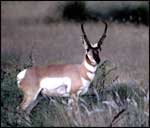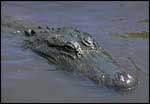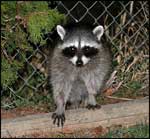Do Animals Live Longer In Captivity Or In The Wild
Related Immature Naturalist Links
:
Animal Life Spans
How long do animals live? Man has been trying to respond this question for years, merely until recently most of the life-span data resulted from keeping historic period records on captive animals. Although these records showed how long animals could live, the data was misleading.
Captive animals are protected from drought, alluvion, fire, and predators; they are fed regularly; and if injured or exposed to disease, they receive medical attention. This care helps them to live long, healthy lives. Yet, wild animals do not accept these advantages. They live simply as long equally they are able to defend themselves and observe food.

Studying how long animals live in the wild is difficult, and scientists accept been working on this subject for many years.
Determining the age of wild animals is very hard, but research is producing some of the answers. Fisheries biologists have learned to read the growth rings formed in the scales, fin spines, ear bones (otoliths), and vertebrae of fish to decide age. During periods of rapid growth, the rings are far autonomously, simply when growth is retarded, every bit in winter, the rings are close together. By counting the areas of concentrated rings, the biologist tin can tell how many winters have passed. This aging method is more accurate in the Northward, where seasonal temperatures are farthermost, but information technology is not completely accurate since conditions other than winter are known to retard growth occasionally.
Some turtles too grade yearly growth lines on their shells. In the case of the box turtle, these lines are considered reliable for the outset five years and fairly accurate for the next ten. Simply afterwards the turtle reaches fifteen years of historic period, the lines are no longer of any value in telling historic period.
Biologists can determine the age of some mammals past studying their teeth. The number and type of teeth point age in sheep and goats, but wear on the jaw teeth reveals a deer's age. As the deer grows older, sure portions of its teeth are worn away from use. By examining the amount of wearable, the age of the deer can be determined. This method is adequately accurate upward to eight and a half years, but in one case the deer passes to this point, the teeth are worn too smooth to be of whatever assist. Equally the teeth wear down, the deer is unable to feed properly. As a result, few deer alive longer than x years in the wild. Males of some species of wild sheep are believed to show age past growth segments in their horns; however, the segments remain the aforementioned afterwards twelve or fourteen years, then older males cannot exist properly aged.

The maximum age of convict animals is usually older than that of wild animals because wild fauna must feed and defend themselves and they receive no medical attending. In captivity this alligator tin live more than fifty years.
The whale has a waxlike plug in its external ear. This earplug increases in length with age, and scientists believe a set of its alternating low-cal and nighttime layers represents one twelvemonth of growth. If this is true, whales have been credited with much longer life spans than they really have. Zoologists once believed whales lived 150-200 years, but the waxlike earplugs from hundreds of whales defenseless in the Antarctic angling grounds testify that none of the whales was more than than 60 years onetime.
Trying to continue track of a wild bird to see how long it really lives would be adjacent to impossible; however, ornithologists take been able to age some wild birds from information received through banding efforts. A banded osprey was found dead on June 1, 1935. From the banding record, they discovered this one osprey, which had been banded equally a nestling on June 19, 1914, was able to survive in the wild for almost 21 years. A European black-headed gull was captured 20-four years and ten months later its banding, and a Caspian tern was collected twenty-six years subsequently receiving its band. Records such every bit these requite some idea of life-bridge potential, but few small birds grow old in the wild considering predators and accidents usually cut their lives short.
Brute size does not necessarily signal life span. The wild panthera leo'southward age compares with that of a domestic cat; larger breeds of dogs take shorter life spans than smaller ones; and a Shetland pony can outlive a regular equus caballus. Yet, larger animals, as a rule, do live longer in the wild than smaller ones. One reason for this is that more dangers face the smaller creatures. Ascent waters from a heavy pelting can drown a small animal or destroy its home and food supply while merely causing the larger animal to get wet or be uncomfortable. Predators also feed heavily on the smaller animals such equally rabbits, mice, birds, and insects. So y'all can meet in that location is a certain amount of safety that comes with size.

Smaller animals as well may live at a faster torso footstep than larger ones. This ways they may breathe faster, have a faster heartbeat, and eat more than food in relation to body size to produce the energy required for this faster footstep. As a result, the smaller animal'southward torso wears out faster, like a motor that constantly must be run at high speed.
The bulk of insects live less than one year. Many cannot endure common cold weather except during their egg phase, so they alive their entire life bike between spring and fall. Some insects, such as the mayfly, alive as adults for only a few hours because they do not or cannot eat. Their whole existence is devoted to finding a mate and reproducing. The adult mayfly accomplishes this job in no more than than eighteen hours. Although brusk-lived equally adults, these insects may spend ane to two years in the larval or nymphal stage before irresolute into adults. Cicadas, which live three to half-dozen weeks as adults, spend two to seventeen years as nymphs.
Activity of a animal also may make up one's mind its life span. The queen honeybee, who spends her time laying eggs for the hive, may live as many every bit 5 years. Worker bees, on the other hand, live no more than six to twelve weeks. During this fourth dimension they are gathering pollen and producing dear. Both the workers and the queen in an ant colony accept long lives for insects. Queen ants may alive for xv to 20 years and the workers equally many as ten years. Nevertheless, the queen termite surpasses them all by living 50 years or more than. Centipedes and scorpions live five to half dozen years.
To give you an idea of how long some convict animals accept lived, the following list has been prepared from data appearing in The World Book Encyclopedia, The Larouse Encyclopedia of Animate being Life, The International Wildlife Encyclopedia, and various other publications. Non all captive animals live this long; these are the record makers. Our cognition of animals in the wild will grow with time, but records from captive specimens may be all we will ever have for some creatures.
| Name of Animal | Life Bridge |
|---|---|
| Antelope (Blackbuck) | fifteen |
| Antelope (Pronghorn) | 15 |
| Badger | fifteen |
| Bat (Guano) | fifteen |
| Deport (Grizzly) | 34 |
| Beaver | 20 |
| Buffalo | 45 |
| Camel | 40 |
| Cat (Domestic) | 30 |
| Chimpanzee | l |
| Deer (Fallow) | 25 |
| Deer (Mule) | twenty |
| Deer (Whitetail) | 23 |
| Dog (Domestic) | 20 |
| Donkey | 50 |
| Elephant (African) | l |
| Elephant (Indian) | 70 |
| Fox | xiv |
| Giraffe | 28 |
| Caprine animal | x |
| Guinea Hog | five |
| Hare | x |
| Hippopotamus | 41 |
| Horse | l |
| Jaguar | 22 |
| Javelina | 20 |
| Panthera leo | 35 |
| Mole | 3 |
| Mountain Lion | 18 |
| Mouse | 4 |
| Mule | 37 |
| Nutria | 12 |
| Opossum | eight |
| Otter | 15 |
| Porcupine | xx |
| Porpoise | 15 |
| Rabbit | ten |
| Raccoon | 13 |
| Reindeer | 15 |
| Rhino | 40 |
| Seal (Common) | 30 |
| Sheep (Bighorn) | 15 |
| Sheep (Mouflon | nineteen |
| Shrew | 2 |
| Skunk | 12 |
| Squirrel (Fox) | ten |
| Squirrel (Greyness) | 18 |
| Tiger | 25 |
| Whale (Blue) | 35 |
| Wolf | 16 |
| Zebra | 30 |
| Name of Bird | Life Span |
|---|---|
| Fundamental | 22 |
| Chickadee | vii |
| Condor | 52 |
| Pigeon | 12 |
| Eagle (Golden) | 80 |
| Goose (Canada) | 32 |
| Heron | 24 |
| Herring Dupe | 50 |
| Jay (Blueish) | four |
| Ostrick (African) | 50 |
| Owl (Snowy) | 24 |
| Pelican | 52 |
| Penguin (King) | 26 |
| Dove | 35 |
| Quail | 10 |
| Raven | 69 |
| Robin | 12 |
| Skylark | 24 |
| Sparrow | 20 |
| Starling | 15 |
| Turkey | 15 |
| Name of Reptile or Amphibian | Life Span |
|---|---|
| Alligator | 56 |
| Boa Constrictor | 23 |
| Bullfrog | 15½ |
| Chameleon | 3½ |
| Cottonmouth | 21 |
| Crocodile | thirteen½ |
| Frog (Leopard) | 6 |
| Garter Serpent | 6 |
| Gila Monster | 20 |
| Lizard (Anole) | 6 |
| King Ophidian | 14½ |
| Python | xx |
| Rattlesnake | 18½ |
| Salamander (Spotted) | 25 |
| Turtle (Box) | 123 |
| Water Snake | 7 |
| Name of Fish | Life Span |
|---|---|
| Bother | fifty |
| Crappie | 6 |
| Flounder | 10 |
| Goldfish | 25 |
| Perch | xi |
| Freeway | 24 |
| Seahorse | six |
| Sturgeon | 50 |
| Trout (Rainbow) | iv |
Additional Information:
Ilo Hiller
1983 Animal Life Spans. Young Naturalist. The Louise Lindsey Merrick Texas Environment Serial, No. 6, pp. 20-23. Texas A&M University Press, Higher Station.
Source: https://tpwd.texas.gov/publications/nonpwdpubs/young_naturalist/animals/animal_life_spans/
Posted by: binettewallard.blogspot.com

0 Response to "Do Animals Live Longer In Captivity Or In The Wild"
Post a Comment